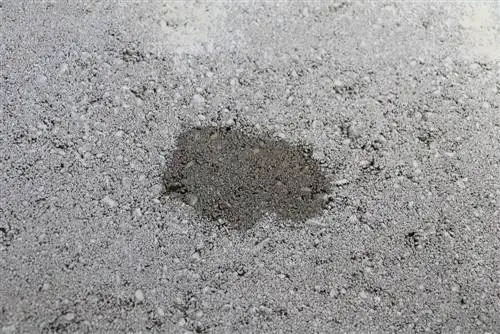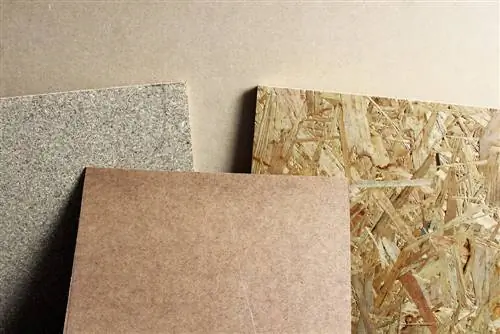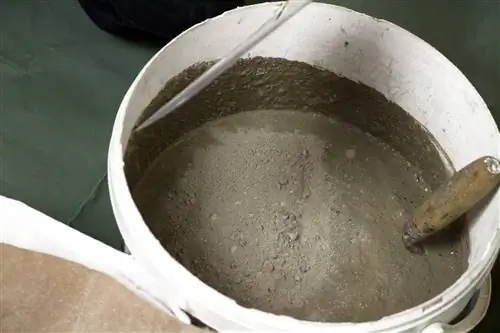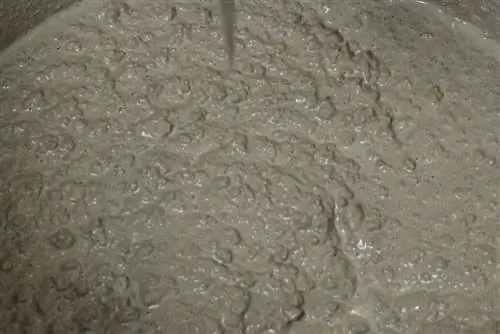- Author admin [email protected].
- Public 2023-12-17 03:39.
- Last modified 2025-06-01 06:48.
Drain concrete offers several advantages due to its water-permeable properties. For example, it is not susceptible to frost damage, can prevent efflorescence on the path surface and - as the name suggests - serves for drainage. However, in order for it to fulfill these functions, it must be mixed and processed correctly. We reveal what you need to pay attention to.
Features
Drainage concrete or drainage concrete has a large-pored structure, which makes it permeable to water. This means it offers various advantageous properties and uses:
- can prevent waterlogging and moisture damage to walls
- is frost-proof
- can prevent efflorescence and cracks on path surfaces
- drains water and returns it to the natural water cycle
- Can be broken cleanly with a wire saw after marking
- serves as a bedding layer under path coverings
- can be used as a load distribution layer under garage entrances, balconies, terraces and the like
In addition, the special type of concrete is also relatively easy to process.
Composition
The drain concrete consists of the components: a binder, the grain and water. Cement or more precisely Portland cement is used as a binder. However, the cement content is comparatively low. The grain size is made up of sand and coordinated grit. There are different grain sizes for concrete. The maximum grain size is between 8 and 22 millimeters.
Mix it yourself
To mix or mix the drainage concrete yourself, you only need two utensils - water and either a mixing attachment for the drill or a concrete mixer. The stirring attachment is sufficient for smaller quantities. For larger quantities, a concrete mixer, ideally a horizontal continuous mixer, should be used. A corresponding device does not have to be purchased, but can be rented.
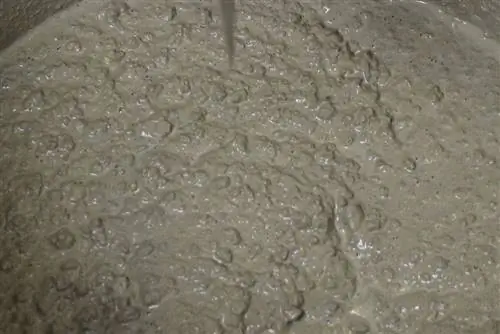
To mix the concrete yourself, just add the required amount of water. Since the concrete is already moist and the processing takes place with a relatively solid consistency, only a little water needs to be added. As a rule, two to three liters of water are sufficient for a 40 kilogram bag of drainage concrete. Here you should pay attention to the manufacturer's instructions and start with the smallest amount of water.
Processing - step by step
Processing the drain concrete does not require much experience or skill. Only the following steps should be observed:
- The concrete reacts alkaline, so skin and eyes must be protected when mixing and processing. Gloves and safety glasses are required. If direct skin contact occurs, the contact area should be rinsed thoroughly with plenty of water. If any of the concrete gets into your eyes, you should also rinse thoroughly and see a doctor immediately.
- Add water to the concrete and mix with a stirring attachment or concrete mixer until a homogeneous mass is formed.
- To check whether the concrete has the right consistency, you can form a ball from a small amount. The procedure is no different than when forming a snowball. If the ball retains its shape, the concrete is mixed correctly and can be further processed or spread.
- When spreading, make sure that the drainage concrete layer should be 15 to 25 centimeters thick. The thickness depends, among other things, on the grain size and the intended use.
- After spreading, the concrete must be compacted in order to create a resilient layer. The concrete must then be covered waterproof. This covering must remain on the concrete for at least three days to allow the layer to dry and harden sufficiently.
The drainage concrete layer can be walked on after 24 hours at the earliest. Laying other materials on the layer can be done directly fresh in fresh or after three days at the earliest. When processing, care should also be taken to ensure that the temperature is not below 5 and not above 30°C. The last point is that the prepared concrete is processed within about an hour and a half.
So you shouldn't mix too large quantities. If complete processing cannot be achieved within this time window, a so-called retarder can be added to the mixture of concrete and water. This extends the processing time to up to around four hours.
Needs
The need for concrete depends on three factors. These are:
- Grain size
- Layer thickness
- Degree of compaction
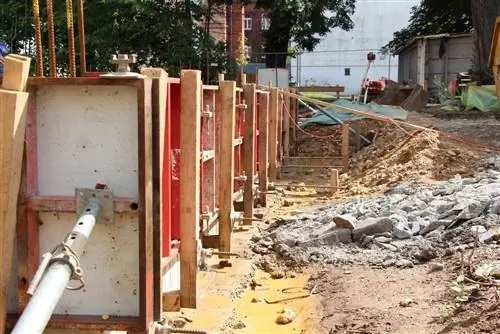
In any case, the manufacturer provides guidance values. These are usually around 20 kilograms of concrete per square meter per centimeter of layer thickness. For a square meter with a layer thickness of 20 centimeters that would be:
20 kg x 1 sqm x 20 cm=400 kg concrete
With a layer thickness of only 15 centimeters, the example calculation is as follows:
20 kg x 1 sqm x 15 cm=300 kg concrete
Prices
The special concrete is usually sold in 40 kilogram bags. Depending on the provider and the grain size, you should expect a bag to cost between six and ten euros. Since 300 to 400 kilograms have to be expected for one square meter with a layer thickness of between 15 and 20 centimeters, the material costs 45 to 100 euros per square meter.
Additional costs for:
- transporting the drain concrete
- the water
- Stirring attachment and drill or renting a concrete mixer
- compressing
- Cover to protect the drain concrete layer
- Safety glasses and gloves
Tip:
If very large quantities of drainage concrete are required, quantity discounts are available from some providers upon request. You should also weigh up and compare whether delivery is cheaper than renting a van yourself. This depends, among other things, on the distance and the quantity that is required, as well as the rental prices for a suitable van.

